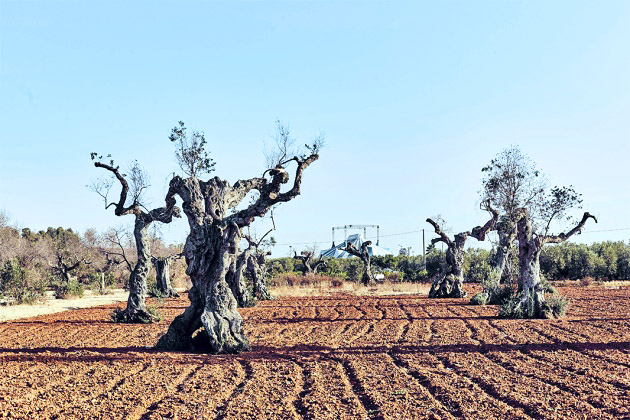Just under five years ago olive oil producers in Italy and other southern Europe countries started to notice that some of their olive trees were dying. They were becoming dried out and twisted, threatening an ancient agricultural activity that has sustained communities for centuries. It quickly became apparent that some sort of disease was attacking the trees, some of which had withstood the elements for hundreds of years.
On the Forestaforte plantation in Ugento, in the region of Puglia, 4000 olive trees used to thrive. The vast olive grove has been in the same Italian family for almost five hundred years. A few years ago a bacteria, now identified as Xylella Fastidiosa, started to attack the trees, drying them up and slowly killing them, reducing the crops’ output by 80 percent in just three years.
Any recovery will be very slow for the nearly-ruined plantation, but it is now an experimental field for researchers and students from the entire Mediterranean area. They are involved in a research project aimed at establishing early diagnostic tools and sharing knowledge to tackle the problem.
The first step is to identify the disease. This is still ongoing to ensure that there are not additional causes beyond the identified bacterial plague. A rush to the cure might leave other issues unnoticed until further devastation is wrought. The bacteria is primarily transmitted from tree to tree by insects. Researchers first had to identify and characterize the pathogen, which was a challenge.
“It is bacteria that exclusively colonizes and acts inside the vessels of the wood,” said Donato Boscia, a phytopathologist with the Italian National Research Council. “It blocks water and mineral salts going from the roots to the leaves. Everything happens exclusively inside the tree. This makes this disease so difficult to deal with.”
As yet there is no known cure for the disease, but early diagnostic tools and apps for pathogen monitoring have been developed and are being tested to prevent its expansion. Now researchers are looking to the future.
“The bacteria is now considered endemic in the affected regions,” according to Franco Valentini, an agronomist at Ciheam-Bari. “That means that it’s no longer possible to eradicate or eliminate it. So we must learn how to live with it. And one way is by developing plants that are resistant or show a low susceptibility to the disease.”
Another agronomist from the Italian National Research Council, Pierfederico Lanotte, says they are making progress.
“We’ve already identified two varieties that are resistant to the disease, known as leccino and fabolosa. But this is only the start, as our objective is to find more varieties that are even more resistant.”
Potentially resistant varieties are grafted on to affected trees for closer monitoring. Local olive oil producers like Giovanni Melcarne, say they hope this research will eventually help them.
“We clearly need to increase biodiversity; we need to think of other olive tree varieties. This will help create a buffer zone and a natural barrier that could guarantee us a better future.”
So the fight continues, but for the families and companies that rely on olives, the process will be both slow and arduous. Like the long-lived olive trees themselves, correction of the problem will be something that will likely span generations.





